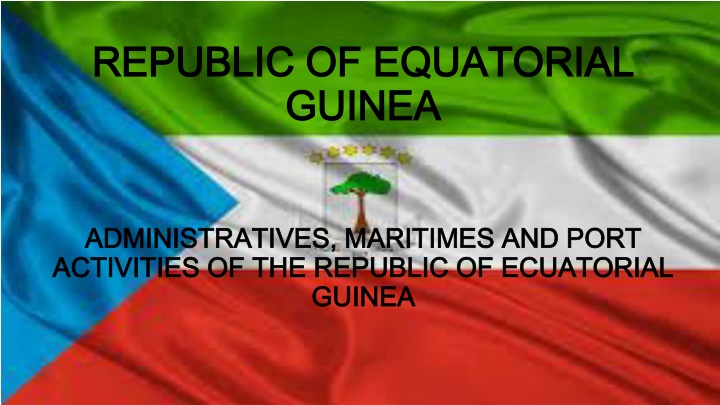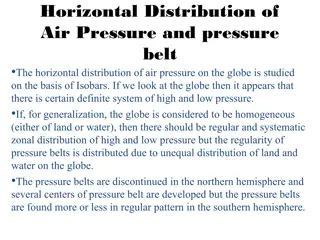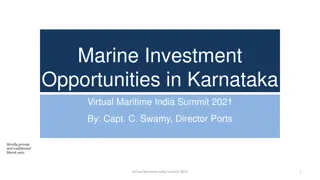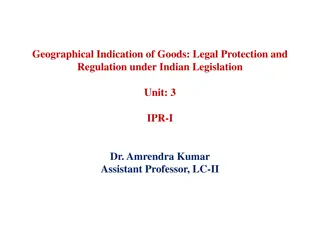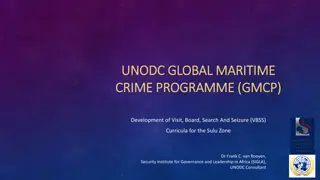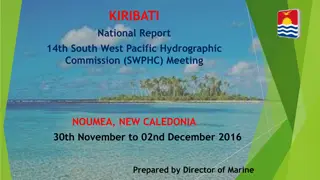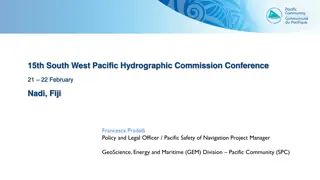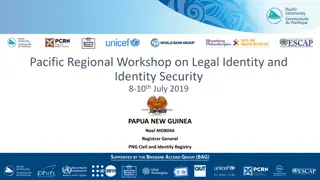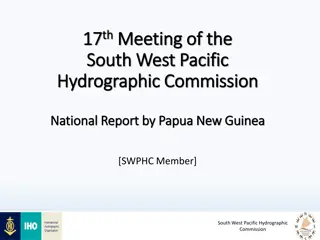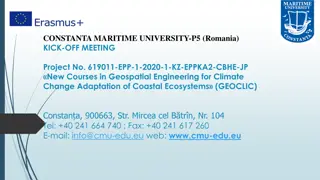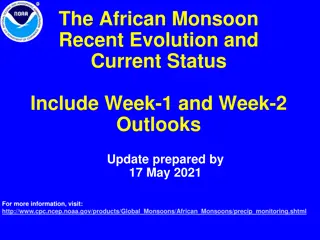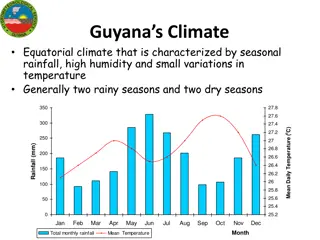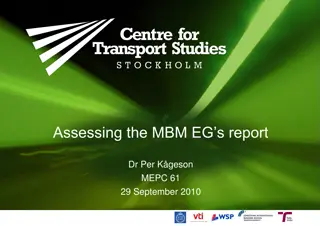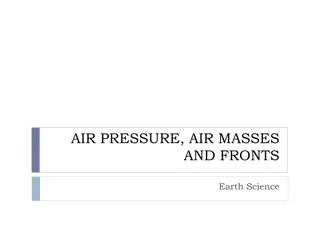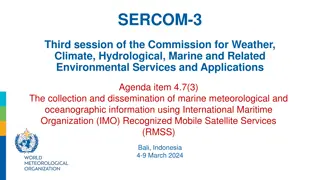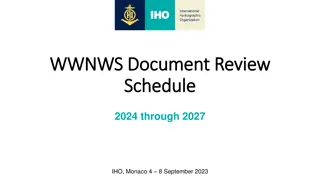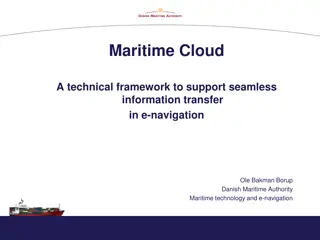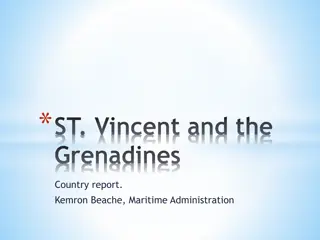Maritime and Geographical Overview of Equatorial Guinea
Equatorial Guinea, a country in central Africa, boasts a significant maritime presence and strategic geographical location in the Gulf of Guinea. With a population of over 1.2 million, it shares borders with Cameroon and Gabon while having maritime boundaries extending 320 nautical miles. The country's maritime sector is a crucial contributor to its economy, with a focus on improving port and maritime activities. The Ministry of Transport and Post plays a key role in regulating maritime operations, overseeing various aspects of maritime services and port management. Recent partnerships with international entities demonstrate a commitment to enhancing Equatorial Guinea's maritime industry.
Download Presentation

Please find below an Image/Link to download the presentation.
The content on the website is provided AS IS for your information and personal use only. It may not be sold, licensed, or shared on other websites without obtaining consent from the author.If you encounter any issues during the download, it is possible that the publisher has removed the file from their server.
You are allowed to download the files provided on this website for personal or commercial use, subject to the condition that they are used lawfully. All files are the property of their respective owners.
The content on the website is provided AS IS for your information and personal use only. It may not be sold, licensed, or shared on other websites without obtaining consent from the author.
E N D
Presentation Transcript
REPUBLIC OF EQUATORIAL REPUBLIC OF EQUATORIAL GUINEA GUINEA ADMINISTRATIVES, MARITIMES AND PORT ADMINISTRATIVES, MARITIMES AND PORT ACTIVITIES OF THE REPUBLIC OF ECUATORIAL ACTIVITIES OF THE REPUBLIC OF ECUATORIAL GUINEA GUINEA
GOGRAPHICAL AND MARITIME LOCTION OF THE REPUBLIC OF ECUATORIAL GUINEA
INTRODUCTION OFMARITIME AND GEOGRAPHICAL LOCATION OF EQUATORIAL GUINEA Equatorial Guinea is a country in central Africa nestled in the Gulf of Africa, with a population of 1,222.442 inhabitants, statistical data dated September 18, 2015; It limits the north with Cameroon, Gabon on the south and the Gulf of Guinea, with more maritime extension, which is of 320.320 nautical miles, and a surface area of 28,052.46 km2, divided in Mane land and Island , Region; the insular region includes the following islands: Bioko Island (where is the national capital is Malabo), formerly known as Santa Isabel Island; Annobon Island and Elobeyes (Elobey Grande Elobey Chico).
The great maritime extension Equatorial Guinea qualifies as an eminently maritime country, it makes us to focus on all aspects that make transport and maritime and port activities; for this, we are finding improvement solutions in order to enable the maritime sector, hydrographic as one of the major contributors to the national economy to the Treasury.
NATIONAL LEVEL STRUCTURE OF PORT SERVICES Ministery of Transport and Post Government Advisor for Maritime Signals General Secretary General Director of Ship Registration General director Of Maritimes Signal Port Management GD
The Ministry of Transport Post and Communication as the regulatory body of maritime activities, is currently comprised of four directions as follows: General Director of Merchant Marine. General Director of Ports. General Director of maritime signals. General Director of Ship Registry and Maritime Company The four major direction Maritime binding activity of Equatorial Guinea, are working closely to improve services, maritime , port and Hydrographic activities in the Country. As a sign of these works to improve the maritime sector; very recently we had the visit of the technical of the American Coast Guard, which conducted inspection visits of national busiest ports. Also in these times we have a delegation from Spain Mercantile Company CERSA AFRICA SL, for technical assistance and consulting structuring levels of port services and the navy of our country. 1. 2 1. 2.
EQUATORIAL GUINEA STRATEGIC TO THE HYDROGRAPHIC POLICIES The national plan is draw is to made new infrastructure of the hydrographic, and Cartographic, Equatorial Guinea as heling the port activities, and continue use the old colonial infrastructure hydrographic from 1972, until now. .
Long-term plans have been marked as specific objectives of the national maritime policy: The national maritime management shall meet the following specific objectives: Promote the growth of the national merchant fleet to transport general cargo, oil, fishing Hydrographic and tourism, ensuring their agility, efficiency, reliability and competitiveness, to ensure the best conditions of quality and freight running with international standards. Ensuring the professional competence of staff of Merchant Marine, compatible with the requirements of current technology to ensure the recruitment and retention of such personnel in any labor market academic levels.
Regulate the activities of companies and shipping agencies, guiding their services guarantee quality, efficiency and cost competitive internationally. Develop maritime activities in a healthy and sustainable environment, through the care and conservation of the ocean, to prevent deterioration and to restore it if it has been affected by applying management based on maintaining the ecosystem and supported by monitories permanent scientific.
DATA COLLECTION, REPORTING AND MONITORING SYSTEMS Gathering information from port activities and maritime Fulfill commitments voluntarily providing data and contribute to their collection are two of the main administrative problems faced by managers. Often, the provider believes that providing the data is a waste of time, meaningless, and / or fear that this information may favor third parties. Experience clearly shows that there are two characteristics that favor the ability to collect accurate and timely data. They are: Mutual trust between staff and the authorities (including data confidentiality); The ease with which can be collected, compiled and distributed data. National Maritime and Seaports. Machines and Port Equipment.
The structure and activities carried out in the positions of the nation make and obtain a particular type of machinery, such as sliding gantries and cranes esplanade, forks, wheelbarrows, trucks, etc. Maritime Security and Protection. Process of elimination of oil spill into the ocean. The Republic of Equatorial Guinea despite being one of the oil producing countries, fortunately so far has not known what is in the above dimensioned lot: spill oil into the ocean. But as a preventive measure, we are taking the most of the requirements of the IMO. IMO adopted a Code Casualty Investigation mandatory and go along with the implementation of the identification system and long-range tracking of ships (LRIT), when the Maritime Safety Committee (MSC) met in May in London to its 840 session.
OTHER RELEVANT INFORMATION. Information seaports and ships length of the coast (Km2) Type and number of ships in international trade operations They have participated in an international project development or capacity building? Laws relating to port and marine The laws linking the port and the marina are all that are linked to compliance with international conventions such as: a) The International Convention for the Safety and Human Life at Sea (SOLAS) b) The Pollution Prevention at Sea (MARPOL) c) Communications System (INMARSAT), etc, etc.
There is a school or special institution for maritime training and management of seaports? At the moment we have no school or institution for maritime training; but as we said the plan of the Government of the Republic of Equatorial Guinea is to promote all sectors and in this case the maritime with the construction of large infrastructures, so we can include this idea. Companies in charge of the construction and expansion of ports of national scope, so far bearing the task of training personnel who will be employed in these fields, each group in its work section as you can see in the following images.
